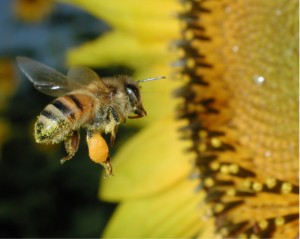You've learned about some of the amazing things that honey bees do, but did you ever wonder exactly how they do it? Honey bees have super special bodies that help them do these incredible jobs. Let's take a closer look at the fascinating anatomy of a honey bee:
 |
| Static electricity: the balloon sticks to your hair... |
- Hair
 |
| ...and the pollen sticks to the bee's hair! |
That's right - hair! A honey bee's fuzz is more than just good looking, because it actually serves a very important purpose. To illustrate, we'll do a simple experiment.
Step 1: Blow a balloon and tie to close it.
Step 2: Quickly rub the balloon back and forth a few times
against your head (make sure your hair is clean and dry).
against your head (make sure your hair is clean and dry).
Step 3: Slowly move the balloon away from your head and watch what happens.
Your hair sticks to the balloon because you've created static electricity between your hair and the balloon. When the honey bee flies through the air, the action of the breeze blowing through her hair causes static electricity to develop. When she lands on a flower, the static electricity makes the pollen stick to her hair, just like the balloon stuck to yours!
Every honey bee has one pair of antennae (pronounced "an-ten-uh") on her head, which she can move using tiny muscles. The antennae are the noses of the bee, although she also uses them to touch, taste, and even hear. The bee even uses her antennae to measure flight speed – kind of like the speedometer in your car, which tells how fast you're driving!
- Pollen baskets
 |
| A pollen-dusted worker bee with lots of pollen in her baskets |
Like all insects, honey bees have six legs in three pairs. The third pair of legs on a honey bee, however, are very special. Built in to a worker bee’s third pair of legs is a concave area (meaning that it caves in, like a bowl) with a fringe of tiny hairs around the edge, making a sort of basket on each leg. When the pollen sticks to the bee’s hairs, she uses comb-like structures on her second pair of legs to comb the pollen out of her hair, and then packs the pollen into her pollen baskets. The stiff hairs lining the rim of the baskets help the pollen grains to stay in place. Once her baskets are full, the worker bee will fly back to the hive, and other worker bees will use the pollen to feed the brood (baby bees) for protein. You can eat pollen, too! It’s wonderful in cereal, smoothies, peanut-butter-and-honey sandwiches, or even on ice cream! Find it at your farmers’ market or health foods store.
“Proboscis” (pronounced “pro-boss-kiss”) is the name for a honey bee’s tongue, which she uses like a short straw to suck nectar, honey, and water, feed other adult bees, and taste. It’s a complex tongue made of several different parts which each serve a unique purpose.
Hair, antennae, pollen baskets, and a proboscis are just a few of the extraordinary features of a honey bee’s anatomy which she uses to do some truly amazing and very important things that benefit you and me, too.



No comments:
Post a Comment
Thank you for your comment/question! We are busy buzzing across American spreading the sweet news about honey and beekeeping, but we will do our best to respond in the next 24 hours. We appreciate your patience!